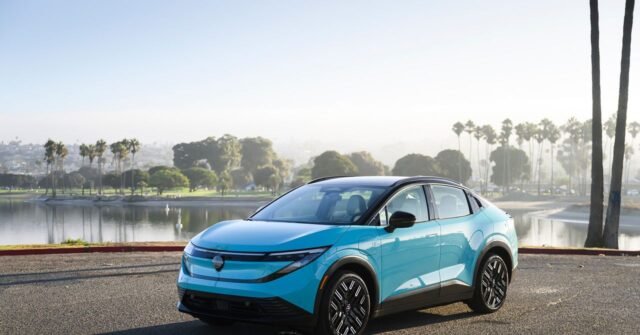Nissan quotes 160 kilowatts (214 horsepower) and 252 pound-feet of torque from the single motor driving the front wheels. Acceleration is adequate in standard drive mode, and Sport provides a bit more boost, enough to spin the front wheel on the inside in turns. Eco mode was underwhelming, and while there’s a personal mode to customize your own mix of settings, we’d be shocked if anyone ever used it.
Nissan offers four levels of regenerative braking, controlled by paddle shifters on all but S+. Then there’s the E-STEP mode, which is almost one-pedal driving. Regen isn’t as powerful overall as some rivals, but frustratingly it only kicks in at about 7 mph, meaning the driver has to brake to a full stop. No one-pedal driving in 2025?
Roadholding is predictable with predictable understeer when pushed. The standout feature is the Leaf’s steering. Overall, steering feel and response are more noticeable in an EV than in a gasoline car, as the powertrain is smoother and the battery weight is lower on the vehicle, lowering the center of gravity and reducing body roll. In 2010, the 2011 Leaf’s steering could only be described as “numb.” Thankfully, times have changed.
Nissan’s latest Electric Power Steering (EPS) design isn’t unique to the Leaf, but it could prove to be the best in the small EV. Engineers moved the motor from the steering column to the rack itself, giving them more flexibility in tailoring steering feel to different models and customer preferences—as measured by factors like steering effort gain, linearity, and wheel response to their criteria.
The result is one of the nicest and most direct EPSs we’ve driven. It’s better than its Korean rivals, though we can’t speak to the 2027 bolt-on just yet. Is it as good as the Porsche Taycan? No. But it’s damn good for a car in this price range.
Comfortable seats, legroom compromises
Nissan notes that the new Leaf’s cabin is longer than the outgoing model’s thanks to its shorter nose. The front seats, based on the company’s latest zero-gravity design for lumbar support, are indeed comfortable and supportive, but four 6-foot adults will probably still have to adjust the front seat to get enough rear legroom.
The most striking impression I took away from the 160 miles was the remarkably quiet cabin. Tire noise and road rumble were about all you could hear; there was virtually no wind noise or electronics to be heard. That’s an impressive level of improvement for a $30,000 car, and some of the competition would do well to figure out what magic Nissan is using and replicate it.














